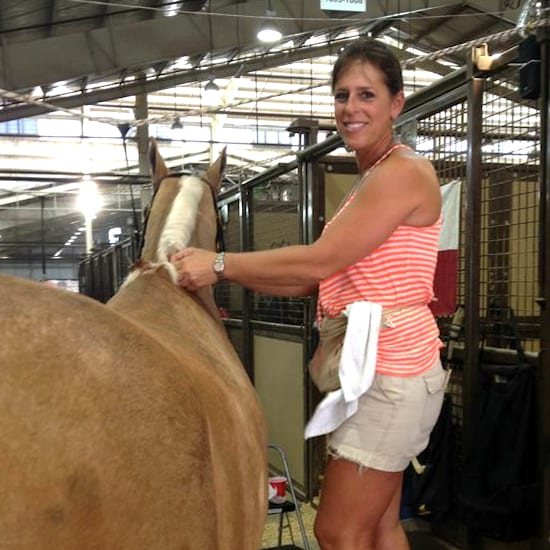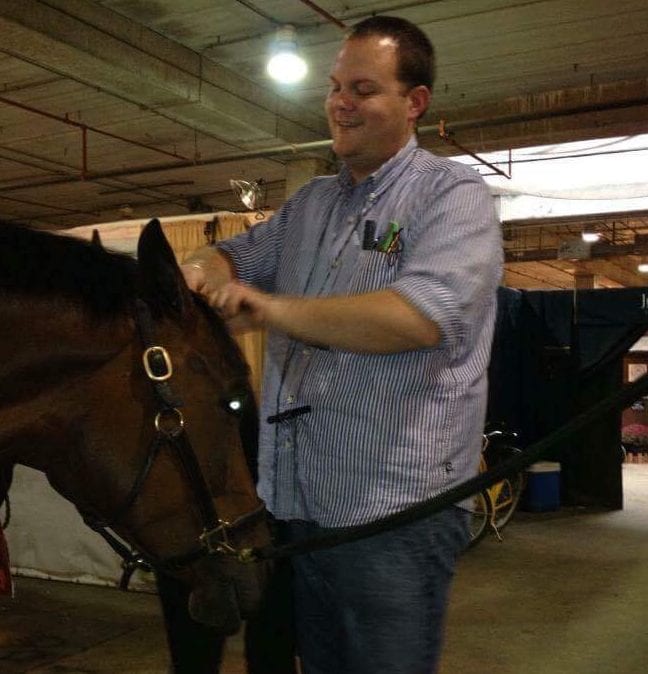While we think our lives are tough, it does not even compare to the exhaustion that the Congress imposes on the professional banders and braiders.
As many complain about not getting a nap after a full night of sleep, banders and braiders are often pulling an all-dayer after pulling an all-nighter. When you are on coffee number two after being awake for an hour, they are on coffee number “whatever keeps my hands moving and eyes open” after 20 hours.
Aside from the long days, there is more organizing, scheduling and communicating required to provide these services at the Congress. It just might be the most demanding job at this horse show due to banded and braided manes being a standard in a majority of the events.
From exhaustion to satisfaction to organization, this job proves to be difficult at the largest single breed horse show in the world. Four of the industry’s finest banders and braiders, Tina Buffkin, Julie McGuffie, Tara Landon and Patrick Lee, were interviewed to give us an inside look at their lives at the Congress.
Tina Freeland Buffkin
 For over ten years, Tina has been advertising her services at the Congress, as well as at weekend shows. What started as only braiding her own horses, turned into her profession and primary income.
For over ten years, Tina has been advertising her services at the Congress, as well as at weekend shows. What started as only braiding her own horses, turned into her profession and primary income.
“When I started showing AQHA in 2003,” Tina explained, “I banded and braided my own horses. My friends noticed that I was skilled at it, so I decided to start doing it professionally.”
After practicing and gaining more experience, she began to advertise her services at the Congress, which is the most significant portion of her income every year. Although the Congress is financially beneficial for Tina, it does have its challenges.
“The Congress is both stressful and exhausting because I have to know the schedule, recognize when each of my customer’s horses shows and plan my timing to get them all done.” Tina has a full schedule a month out from the show, with 15 to 20 horses planned per day on average.
Aside from the stress of the scheduling, Tina explains that it is a rewarding job and she says, “It is exciting to see a horse whose mane I banded or braided place or win at such a prestigious show. It is extremely rewarding to be a small part of making a Congress Champion.”
Julie McGuffie
 Just like Tina, banding and braiding is Julie’s primary income, with the Congress being the most critical and significant show of the year.
Just like Tina, banding and braiding is Julie’s primary income, with the Congress being the most critical and significant show of the year.
She handles a lot of horses and clients, and she says, “I typically have about 100 horses to maintain during the Congress, and I can do as many as 30 per day. It is very stressful because of the daily schedule, working with horses from a variety of classes and working for large barns. It takes about two weeks to plan my schedule.”
Because of her demanding hours, Julie will occasionally have to work for over 24 hours straight, and she explained that you have to “go until you get the job done.”
Julie plans and organizes her schedule to ensure that her timing is compatible with her clients. “I don’t want to show up at their stalls while they are out riding and practicing,” she says.
The horses Julie works on at the Congress are the same she works on at shows throughout the year. “I have too many customers to work with anyone else, especially at the Congress, but I work with my customers year round, and they all have wonderful horses to work on.”
Tara Landon
 Tara originally learned how to braid when she was a kid because banding was not yet introduced. However, once banding became popular, she quickly learned and developed her skills until she was able to offer her services at the Congress.
Tara originally learned how to braid when she was a kid because banding was not yet introduced. However, once banding became popular, she quickly learned and developed her skills until she was able to offer her services at the Congress.
“The Congress was, and still is, a great place to make quick money. If I was limited on the days I could be there, I would work in the sale barn around the clock to fit in as many manes as I could in a short timeframe.”
Tara bands and braids year round, with the Congress being her biggest show of the season. Aside from doing just manes at shows, she has also braided many tails. “Braided tails have become very popular,” Tara says, “I have been braiding tails at every show and at the Congress.”
Aside from the long hours, Tara says she still loves her job. “My favorite part about this job is contributing a small part, even though it may be invisible, to someone’s image. When I hear their name get called, whether it be top 10, top 5, reserve or champion, I get a lump in my throat. It’s like a proud parent moment.”
People who can band and braid are in high demand at the Congress so Tara encourages anyone with the talent to consider doing some manes. “If you have the skills but don’t know how to round up the work, ask one of the full-timers. Even ask to work with us, we would love the extra help.”
Patrick Lee
 Patrick has been braiding and banding at the Congress since 2010 after he decided to quit his job and become a full-time braider the year before. After many years of working at the Congress, he has become accustomed to the schedule.
Patrick has been braiding and banding at the Congress since 2010 after he decided to quit his job and become a full-time braider the year before. After many years of working at the Congress, he has become accustomed to the schedule.
“The Congress is unique because a class can take anywhere from 20 minutes to six hours,” Patrick says. “I try to sleep from 10 p.m. to 2 a.m., braid tails from 2 to 5 in the morning since they have to be done the day of, and then continue to do manes throughout the day.”
Ideally, he allots his time to do no more than ten manes and 15 tails a day.
While Patrick recognized the rewarding aspects to his job, just as the other three braiders, he pointed out the downfalls.
“It is very frustrating when I show up to do a horse’s mane that is super long or filthy. To avoid this, I am very straightforward about telling my customers how to prepare their horse’s manes so that I can have the best result.”
So, the next time you complain about having a long day at the Congress, think about these professionals standing for hours on a ladder braiding and banding countless manes. Just remember, they are a small but crucial part of the horse show village that helps you look your best before you even enter the arena.
About the Author: GoHorseShow writer, Emily Ambrose of Chardon, Ohio is a freshman at Kent State University. She trains under the guidance of Seth and Amber Clark from Pierpont, Ohio. Emily avidly shows her horses, Play For A Minute, known as Ralphie, who is an 11-year-old all arounder, and Super Yellow Doc, known as Doc, who is a 21-year-old ranch horse. Her love of showing has been strengthened with the support of all of her friends in the Quarter Horse community and will continue her passion through and following the completion of her college career.








